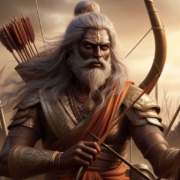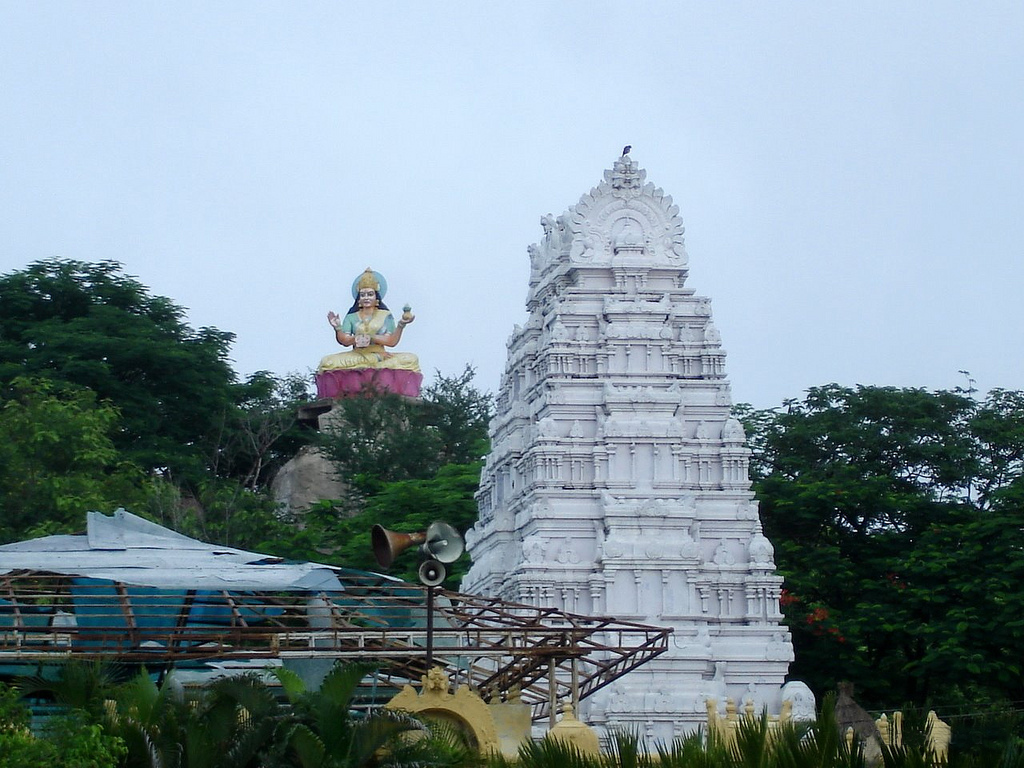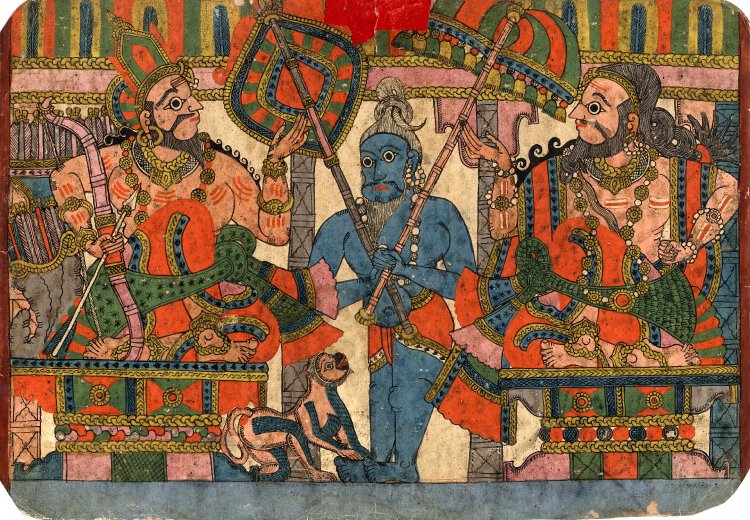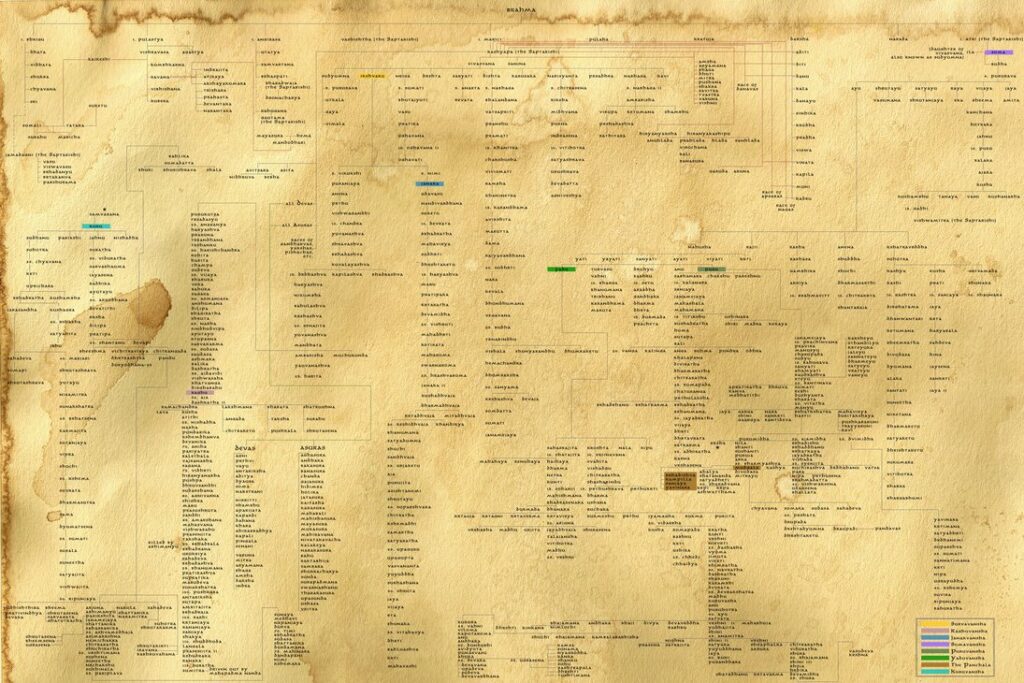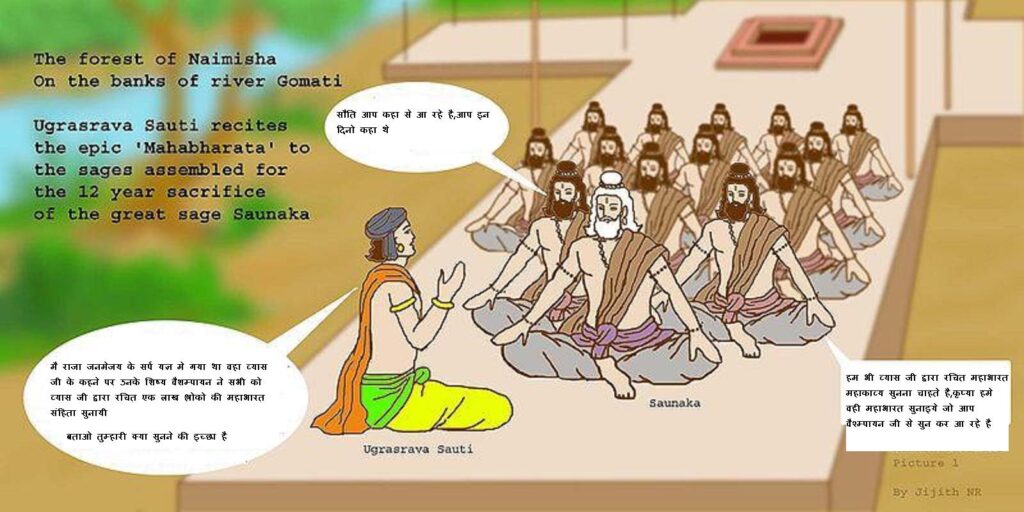Dronavadha Upaparva has sections 184 to 192. However, the discussion of the demise of Drona continues into Narayanastramoksha Upaparva.
The versions of Drona Vadha we know come mostly from retellings in books and on the screen. While the core concept is the same, the (missing) details can make a lot of difference and bring a different perspective. Let’s see what happened in each section. We’ll follow the complete transcreation of Prof. Purushottama Lal for the details.
Section 184 – Arjuna Lets His Soldiers Rest
This section started with Yudhistira listening to Vyasa’s advice. He gave up his plans to attack Karna (for killing Ghatotkacha) that night. However, he ordered Dhrstadyumna to attack Drona and kill him with the help of other heroes. Dhrstadyumna agreed and went to plan his strategy. On the other side, Dhuryodhana planned his next attack on the Pandavas. However, the soldiers were exhausted and barely able to keep their eyes open. After Arjuna killed Jayadratha, the battle resumed through the evening and continued into late night, resulting in Ghatotkacha’s demise.
Arjuna saw the state of his soldiers and told them to rest until the moon rose. The Kaurava soldiers noticed this and asked Dhuryodhana and Karna for a respite. Dhuryodhana grudgingly gave them some time to rest. The soldiers praised Arjuna for being considerate and slept on the ground without even bothering to remove their armor. Here, Vyasa described the beauty of the moonrise. The soldiers woke up to resume the fight.

Section 185 – Conversation Between Drona and Dhuryodhana
Dhuryodhana lashed out at Drona for the nth time. He said the rest had made Pandavas stronger while the Kauvara army was tired. He blamed Drona for having a soft spot for his enemies and urged him to use the celestial missiles.
Drona was angered by Dhuryodhana’s words and replied that despite his old age, he had been using all his strength to fight for him. He said that the soldiers aren’t aware of celestial missiles and that using such powerful weapons against them would be ignoble. But since Dhuryodhana is insistent, Drona would do whatever he can and continue to fight. (In Bhishma Parva, Arjuna told Yudhistira he could destroy the Kaurava army in a few hours by using the celestial missiles, but he wouldn’t do it since those weapons are not meant to be used against humans.)
Drona continued that defeating Arjuna, who could rout the Gandharvas and powerful demons, is not an easy task. This irked Dhuryodhana retorted that Drona could stand by and watch as he, Duhshasana, Karna, and Shakuni killed Arjuna that day (night). Drona simply smiled and wished him luck. He added that Dhurydhana was a fool for thinking they could kill Arjuna.
He also said, “I know you are eager to fight. Why do you want all these blameless Kshatriyas to be cut down also? You are the root of this enmity. You go and fight Arjuna if you must. Your maternal uncle, Sakuni, who is learned in Ksatriya-dharma, is here. You should order him, who is so expert in cheating at dice, to battle Arjuna. You and Karrna ecstatically and stupidly boasted in front of Dhrtarastra… Show us the truth of your words – All three of you!… You have done all that needed to be done. You have no debts. So why fear? Face Arjuna! Fight Arjuna!”
Drona left the battlefield. Dhuryodhana divided the Kaurava army into two formations to attack the Pandavas.
Section 186 – Battle Starts on Day 15
The battle resumed when three-fourths of the night had passed. Aruna, the dawn and sun’s charioteer arrived, lightening the sky. Soon, the sun followed behind. The warriors left their weapons and armor to clean up and perform the morning pooja (and japa). Once done, they donned fresh armor and got ready for the day’s battle. Drona, with his army, went first to attack the Pandava, Somaka, and Panchala army divisions. Dhuryodhana and his army followed behind.
On the Pandava side, Krishna advised Arjuna to keep Drona to his right and others to his left at all times. Bhima went to Arjuna and told him to do the needful and destroy the enemy. Arjuna nodded. As Krishna drove through Drona and Karna’s ranks, Arjuna wreaked havoc on their armies.
Meanwhile, Drona was on the north side of the battlefield, butchering the Panchala army. He killed Drupada’s three grandsons and moved on to demolish the Cedis, Kekayas, and Srnjayas. Next, he killed both the old kings, Virata and Drupada, in short duels. Dhrstadyumna was devastated and vowed to end Drona’s carnage that day. The Pandava and Panchala armies attack Drona together. However, Duryodhana & his brothers, Karna, and Sakuni form a protective ring around Drona. No matter how hard they tried, the Pandava army couldn’t breach the protection.
This annoyed Bhima, who snapped at Dhrstadyumna for not giving his best on the battlefield. He reminded the Panchala prince of his vow to kill Drona but hadn’t achieved it yet. Bhima then attacked Drona’s army and created a breach for the Pandava army to enter.
Section 187 – Battle Progresses
The warriors were tired due to the lack of rest but continued to fight. Temper issues also arose as they were prickly and irritated. Such thick dust arose that it blocked the sunlight. The battleground had three major encounters simultaneously –
- Duryodhana and his brothers fought the twins Nakula and Sahadeva
- Radha’s son Karna fought Vrkodara-Bhima
- Arjuna fought Bharadvaja’s son Drona
Section 188 – Drona vs. Arjuna
Dhuryodhana fought Nakula and lost, while Duhshasana fought Sahadeva. When Sahadeva killed the charioteer, Duhshasana steered his horses and continued to fight. However, he was about to lose to Sahadeva, so Karna stepped in. This made Bhima support Sahadeva, resulting in the duo (Karna and Bhima) fighting each other. Karna killed Bhima’s charioteer, so Bhima jumped into Nakula’s chariot.
Drona rained many powerful missiles at Arjuna – Aindra, Pasupata, Tvastra, Vayavya, and Varuna missiles. Arjuna repulsed and neutralized them with his weapons. Even the gods and siddhis stopped to witness the battle between the two. Neither could outdo the other.

Section 189 – Dhuryodhana vs. Satyaki
Duhsasana clashed with Dhrstadyumna, which the former lost. Seeing this, Krtavarman and three Kaurava brothers arrived to support Duhshasana. Nakula and Sahadeva came to help Dhrstadyumna. With the twins fighting the others, Dhrstadyumna rushed to attack Drona. Dhuryodhana saw this and went to intervene. Satyaki also did the same. Dhuryodhana and Satyaki came face-to-face.
Here, Dhuryodhana uncharacteristically reminisces about their childhood friendship instead of launching an attack. He spoke about how they played together as children and said that he loved Satyaki more than his life and blamed everything on the war and greed. (One has to wonder about this sudden ‘change of heart’. Or, it could be his attempt at manipulating Satyaki and making him emotionally vulnerable. After all, Satyaki had defeated Dhuryodhana a few times on the previous days.)
However, Satyaki replied that they were on the battlefield, which is neither a sabha nor a playground. He went on to add that if Dhuryodhana loved him, he should go ahead and kill him. The duo fights a tough battle, raining countless arrows at each other. When Satyaki overpowered Dhuryodhana, Karna went to save him. Bhima didn’t like this, so he rushed to fight Karna. As the battle raged, Yudhistira ordered the Panchala and Matsya armies to join the fight. (The armies possibly spotted fighting when their kings were killed as they needed a new general to lead them.)
The armies and Bhima, with the twins, launched a fresh attack on Drona. They asked Arjuna to separate Drona from the Kaurava army to make it easier. However, Drona targeted Dhrstadyumna and went on the offensive.
Section 190 – Celestial Message for Drona and the Lie
Despite being killed in large numbers, the Panchalas and Srnjayas continued to face Drona. However, they were also worried that none of them would be left alive if Drona continued the way he did. They also said Arjuna wouldn’t kill his guru, so the chances were bleak. Hearing the repeated murmurs, Krishna told Arjuna that they had to discard dharma for a while, as it was the only way to stop Drona. He gave the idea that Drona would stop if Asvatthaman was dead, so someone should go to Drona and lie to him. The others agreed, and so did Yudhistira, even if he was reluctant. Arjuna, however, was not convinced. Nevertheless, Bhima found an elephant named Asvatthaman, belonging to King Indravarman. He then went to Drona and shouted that Asvatthaman was dead.
Drona was stunned for a second but recovered. He assured himself that Asvatthaman couldn’t be easily killed. Angrily, he resumed his attack on Dhrstadyumna, who retaliated. Dhrstadyumna was so fierce that everyone lost sight of Drona in the arrow shower. Drona decided he had enough and invoked the Brahma missile to eliminate the entire Panchala army at once. He even killed twenty thousand Panchala warriors and Vasudana, along with fifty Matsya heroes, six hundred Srnjayas, ten thousand elephants, and ten thousand cavalry.
His attack was so brutal that a host of rishis, led by Havyavaha, the god of fire, approached him. Visvamitra, Jamadgni, Bharadvaja, Gautama, Vasistha, Kasyapa, and Atri came to visit him (in celestial form, visible only to Drona). Sika, Prsni, Garga, Valakhilyas, Bhrgu, Angiras, and other subtle-formed maha-rishis also followed.
They ordered Drona to stop and said, “You have fought using adharma. Your end has come. Drop your weapons, Drona, and look at us. You must not do any more cruel karma. Such behavior does not become you. Give up your weapons! Take your stand on what is eternal! Your days in the world of humans are over. With your Brahma-missile you destroyed those who had no defense against Brahma-missiles. That is not good karma lay down your weapons. Do not delay. Enough of ill deeds and bad karma! No more!”
The words confused Drona, and seeing Dhrstadyumna made him wonder if his end had come. He turned to Yudhistira and asked if his son, Asvatthaman, was dead.
Krishna convinced Yudhistira that speaking a lie to save lives (of the army) was acceptable. Meanwhile, Bhima came to them and said that he had killed an elephant and informed Drona that Asvatthaman was dead, though Drona didn’t believe those words. He urged Yudhistira to speak the words.
Yudhistira agreed and said, “Asvatthaman is dead!” and he added, inaudibly, “The elephant.” Yudhisthira’s chariot always sped four-fingers above the ground. But the instant he lied, his chariot’s wheels touched the ground and remained ever so. (Shows that no one can cheat the universe.)
Drona was saddened by the news. He remembered the words of the rishis and felt guilty for killing thousands of the Pandava army.

Section 191 – Drona vs. Dhrstadyumna
Seeing his chance, Dhrstadyumna launched a fresh attack on Drona. However, Drona wasn’t yet ready to give up. He tried to summon his celestial missile to retaliate, but the weapons wouldn’t materialize. He also finished all his arrows. For an instant, he thought to follow the rishis’ advice. However, he didn’t. Instead, Drona picked up his Angiras-bow of celestial make and virulent Brahma-danda arrows to fight Dhrstadyumna. He destroyed Dhrstadyumna’s flagstaff and killed the charioteer. Dhrstadyumna wounded Drona in response. Drona sliced off Dhrstadyumna’s bow and all his weapons. He used nine life-threatening arrows to attack the Panchala prince.
Dhrstadyumna rode closer to Drona’s chariot, planning to invoke the Brahma missile. The horses of both chariots got entwined even as Drona destroyed the chariot and disintegrated the mace Dhrstadyumna hurled at him. Dhrstadyumna jumped onto Drona’s chariot with a sword, hoping to kill him with it. Drona used a spear to kill Dhrstadyumna’s horses and freed his chariot.
Here, Dhrstadyumna jumped onto the ground and displayed twenty-one types of swordsmanship moves –
- Bhranta-on the run fencing,
- Udbhranta upraised sword,
- Aviddha whirling sword,
- Apluta all these three together,
- Prasrta sword-tip thrust,
- Srta trick thrust,
- Parivrtta left and right thrusts,
- Nivrtta retreat thrust – With shield in one hand
- Sampata thrust and parry
- Samudirm showing off swordplay
- Bharata limb-plunge
- Kausika unique swordplay
- Satvata under shield-cover thrust.
Drona continued to rain arrows on Dhrstadyumna, who used his sword to repulse them. Drona then nocked a powerful arrow to kill Dhrstadyumna. Here, Sanjaya said that ‘Acarya Drona prepared to kill the pupil who was as dear to him as his own son.’
In the next Upaparva, we read many mentions of how Dhrstadyumna committed a crime by killing his guru. (Until now, there was no explicit mention of Dhrstadyumna being Drona’s student. We can presume that this development occurred during the truce years between Panchala and Hastinapura when the Pandavas were ruling Indraprastha.)
Satyaki saw this and shot an arrow to slice off Drona’s bow. Satyaki wove his chariot in and out between Drona, Kripa, and Karna, giving Dhrstadyumna a chance to get to safety. Seeing him in action, Arjuna (and Krishna) focused on others attacking them. Arjuna continued to enjoy Satyaki’s prowess and asked Krishna to see how easily the warrior was controlling the enemies and keeping them in check.
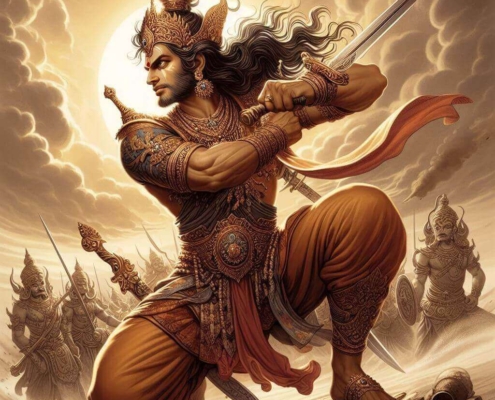
Section 192 – Drona’s Demise
Infuriated, Dhuryodhana, Karna, Kripa, and other Kaurava brothers wounded Satyaki with arrows. He continued to fight fearlessly. Yudhistira, Bhima, and the twins go to reinforce him. Yudhistira told a section of his army to advance toward Drona, who was still fighting with Dhrstadyumna. The Srnjayas did as ordered.
Drona experienced signs of end, like the trembling of his left arm and a twitch in the left eye. Yet, he continued to fight. He wanted to die after a good fight. However, the Pandava army encircled him. He killed twenty thousand warriors and a hundred thousand elephants (we aren’t sure if he did this again or if it’s a repetition of the earlier count). He tried to invoke the Brahma missile again.
Bhima rushed to Dhrstadyumna, who was still on the ground, and helped him into his chariot. He encouraged Dhrstadyumna to go and fight Drona, reminding him that he was born for this very purpose. The Panchala prince grabbed a sturdy bow and recommenced his attack on Drona’s army and Drona. The two of them fought again, with Dhrstadyumna neutralizing Drona’s arrows. However, Drona wounded him again.
Bhima was annoyed. He positioned his chariot close to Drona’s and said, “If learned Brahmins, dissatisfied with their duties as Brahmins, stayed away from the fighting, no Ksatriyas would lose their lives. Ahimsa is said to be to highest dharma. Its root is the Brahmin, and you are the ideal Brahmin. Lapped in love for your son, your wife, for wealth, like an ignorant fool, you have killed so many others. You should be ashamed! For the sake of your son, you have chosen adharma. Forgetting your duties, you have slaughtered those who follow their duties. And the person for whose sake you are fighting, for whose sake you are living is sprawled on the field at the back – He is dead – You do not even know where! How can you disbelieve the word of Dharmaraja Yudhisthira?”
Drona heard Bhima and laid aside his weapons. He called out to Dhuryodhana, Kripa, and Karna and said, “I tell you this again and again: Do your very best on the battlefield. May the Pandavas favor you by not harming you. I am laying aside my weapons.” He then loudly said, “My son!” and sat in his chariot in a yogic position.
Dhrstadyumna set aside his bow and grabbed a sword. He rushed towards Drona, who was now in deep meditation. A light rose from Drona’s body and traveled toward Heaven. There, it merged with the celestial light and disappeared. The sky suddenly seemed to have two suns and was dazzling with bright intensity. In a blink, everything was normal again. Celestial cries could be heard from above, praising Drona. Dhrstadyumna was stunned for a while, not knowing what to do.
Here, Sanjaya said that only five people witnessed this event – himself (Sanjaya), Krishna, Arjuna, Yudhistira, and Kripa. No one else knew that Drona’s light had already left the body. They saw Dhrstadyumna recover. He went and held Drona’s head by his hair, aiming for the kill. Drona did not move.
Arjuna shouted, asking Dhrstadyumna to not kill the guru. However, Dhrstadyumna didn’t pay heed. He severed Drona’s head from the body and flung it toward Dhuryodhana’s chariot.

Bhima hugged Dhrstadyumna and told him he would embrace the Panchala prince again after the death of Karna and the Kaurava brothers. He roared a war cry, which terrified the enemy’s soldiers.
The Pandava army attacked and scattered Drona’s army. The Kaurava army was terrified and shocked. Unable to react quickly, they fled from the field. Even Dhuryodhana, Karna, and others fled from the field immediately.
Check out more stories from Mahabharata here, here, and here.
***
Picture Credit: All images have been made on Microsoft Bing.

